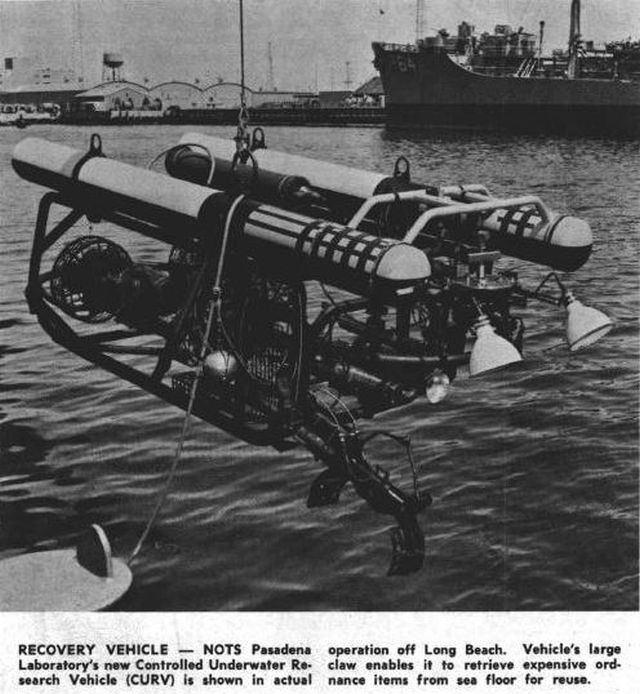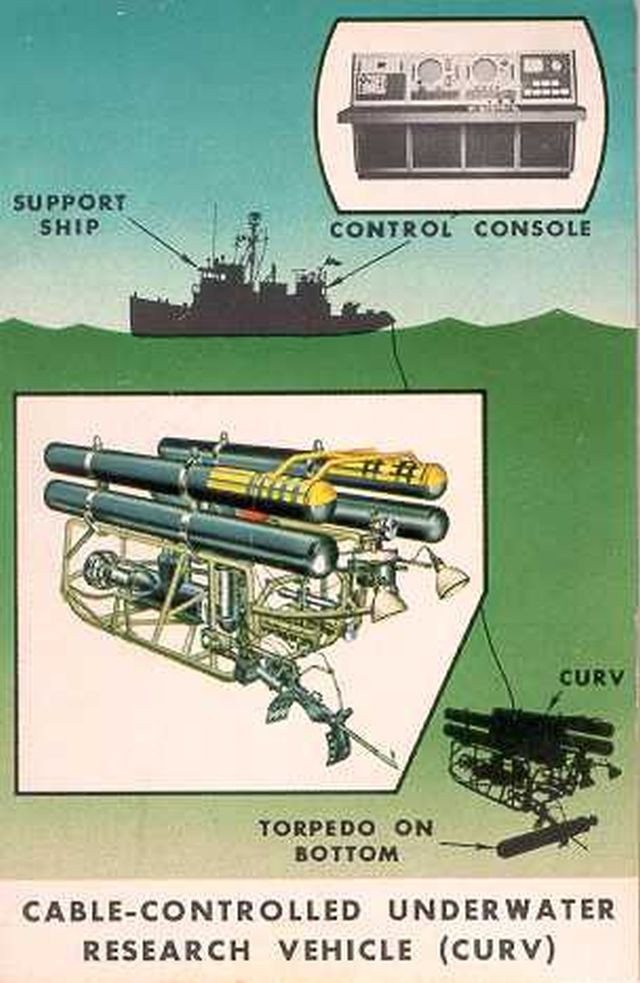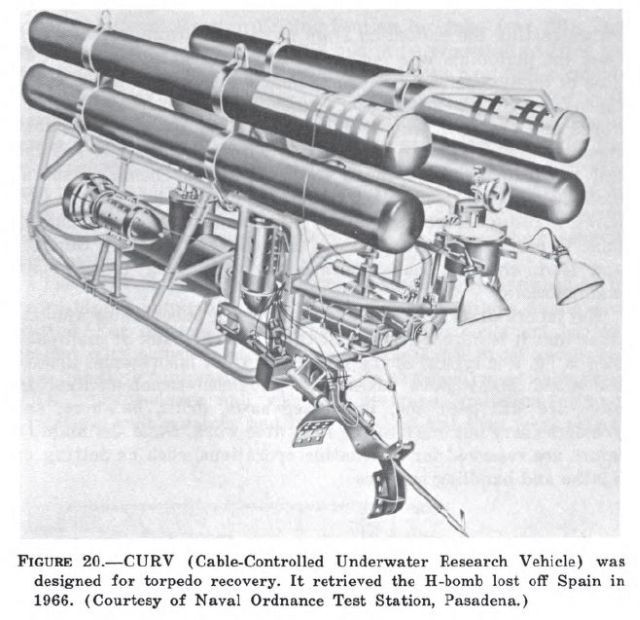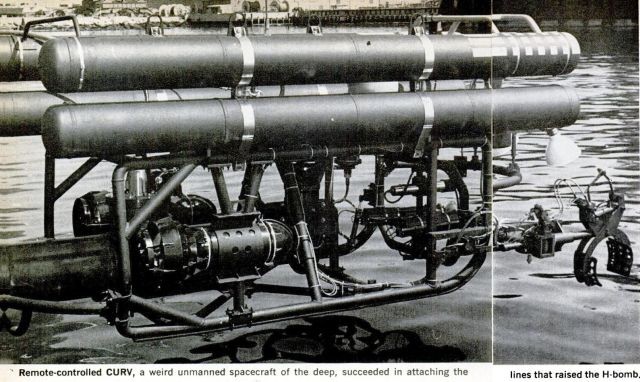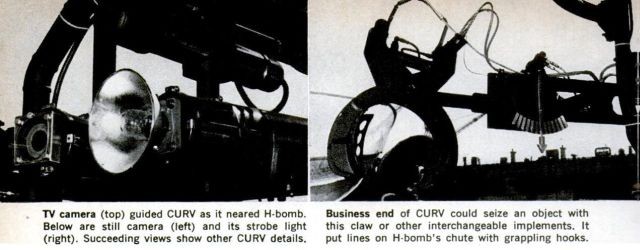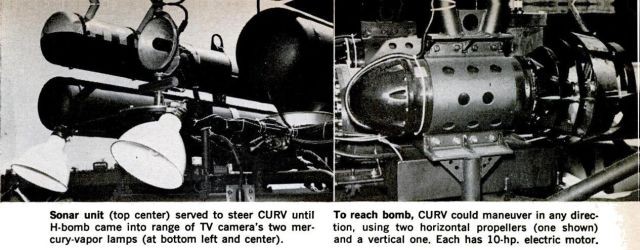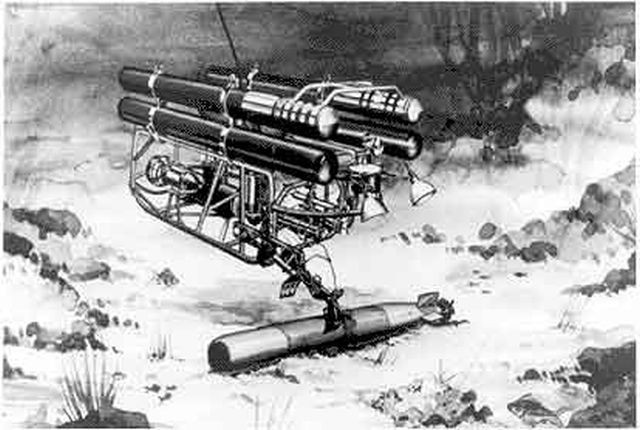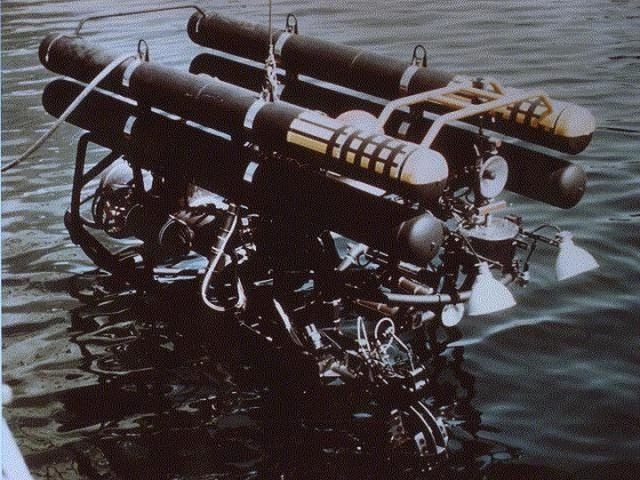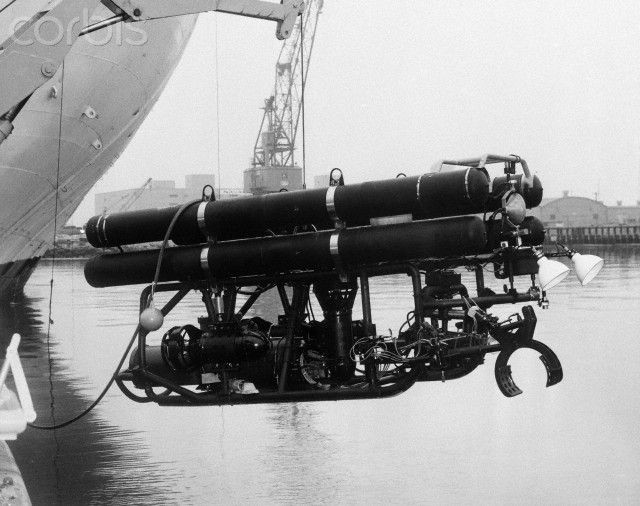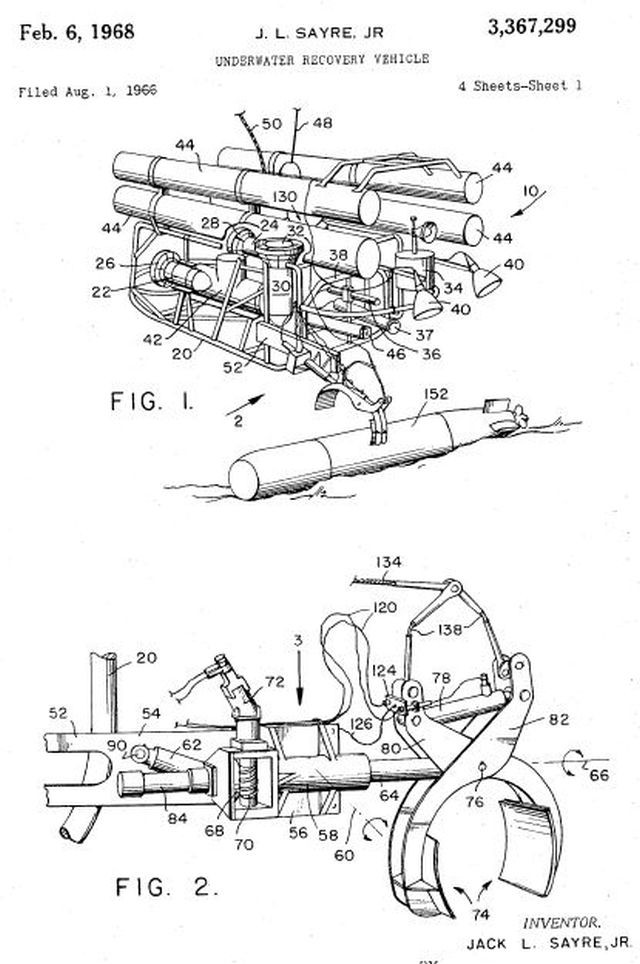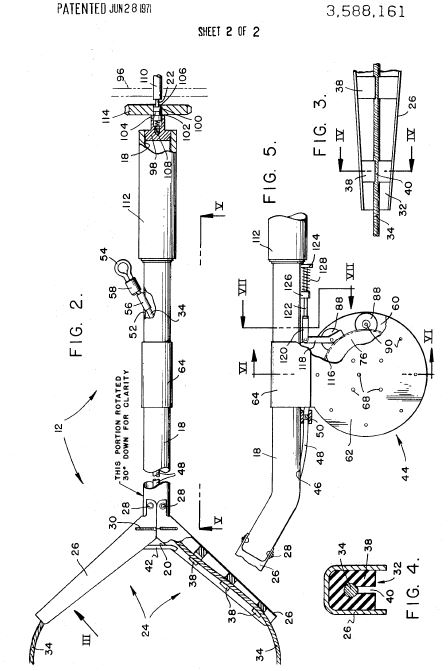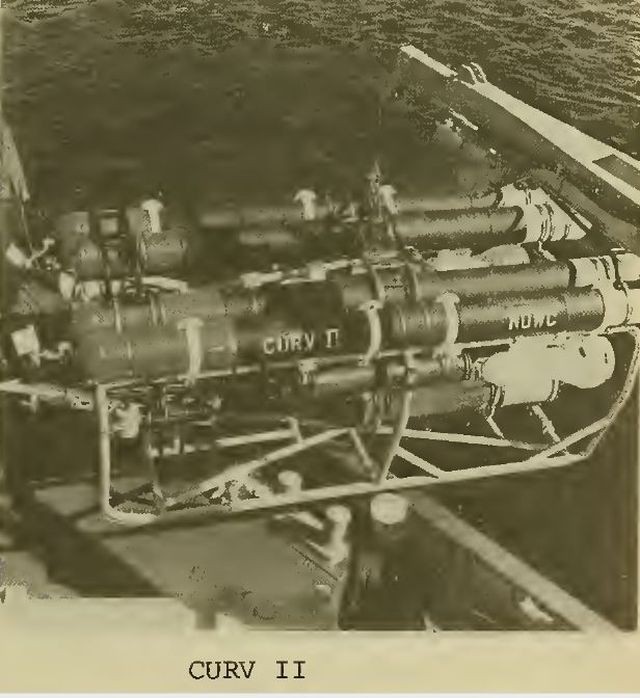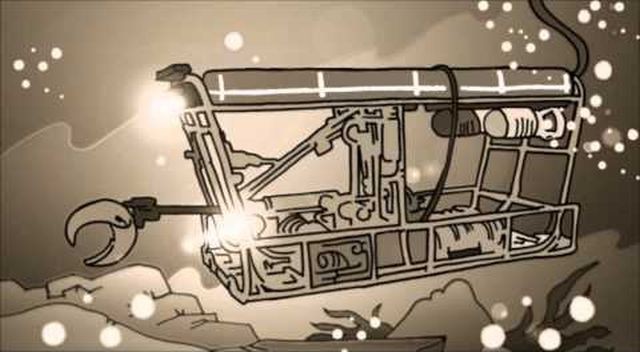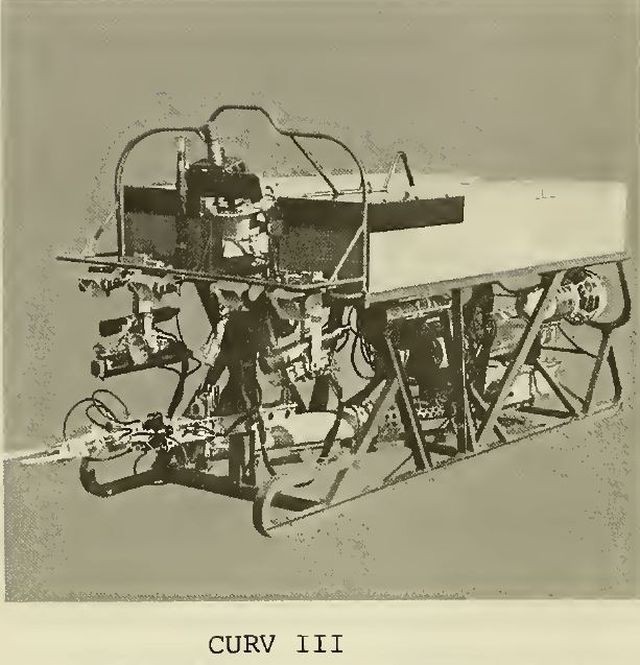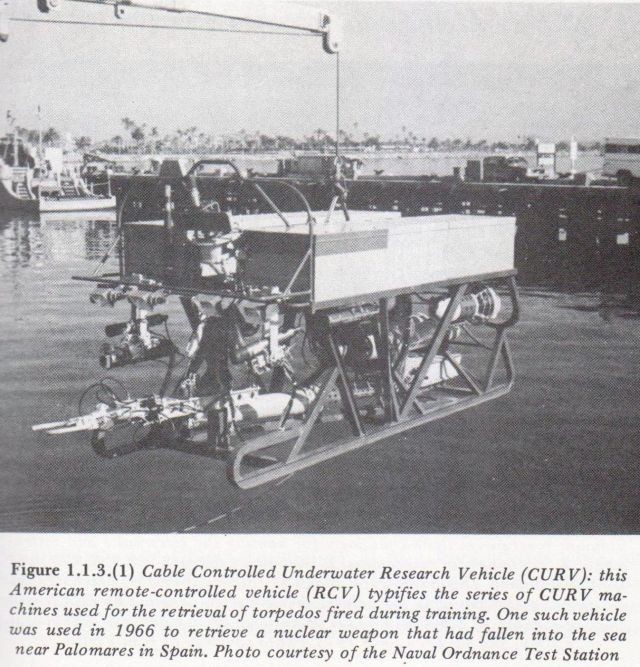1965 – CURV Cable-controlled Underwater Recovery Vehicle by Jack L. Sayer Jr.
NOTS-Pasadena Scientists Develop Recovery Vehicle from Rocketeer, July 9, 1965.
CURV Pays Its Way Recovering Valuable Deep Ocean Ordnance
NOTS Pasadena Laboratory has disclosed a new and unique method of reclaiming small ordnance items from the ocean floor. CURV—which sounds like a bend in the road or a part of the human anatomy, in Navy language means Cable Controlled Underwater Research Vehicle.
It promises to be one of the most useful, capable, and money-saving devices yet discovered for recovering expensive hardware from the bottom of the sea.
Boon to Economy Program
In any missile or torpedo program, hundreds of thousands of dollars are expended for test hardware in dummy form. Every torpedo that can be recovered represents a taxpayer's investment in both effort and money.
First, the hardware can be reused — saving the price of a duplicate. Second, and perhaps the most important, is the ability of the scientists and engineers to study the recovered hardware to determine areas of weakness or malfunction, thus correcting and improving the design in a minimum of time.
In use by NOTS Pasadena Laboratory, CURV is an unmanned vehicle comprised of a tubular aluminum frame 4-ft. high, 4-ft. wide, and 11-ft. long, upon which are mounted four ballast tanks (two on each side), three propulsion motors (port, starboard and vertical) with screws, a hydraulic system, and acoustic instrumentation components; also, a transistorized TV camera with two mercury vapor lights, a deep-sea documentation camera with a strobe light, a recovery claw, and a recovery buoy.
CURV weighs approximately one ton, and operates to a depth of 1000 feet at present. It will operate to a depth of 2000 feet when current modifications are completed.
Tug Supports Operation
The CURV is supported by the YTM 759, a tug, which not only transports it to the designated search and recovery location but also houses the control console from which the five-man CURV crew directs, controls, and monitors recovery operations.
After the general location of the target has been established by range methods and the topside checkout has been accomplished, the CURV is lowered over the side of the anchored support ship and submerged. It is then directed to the required position for recovery of the object on the ocean bottom.
Search and Recovery
Search and recovery procedures using CURV are described by the Navy as follows: (l) Locate target with CURV's high resolution sonar. (2) Classify target with TV camera and document event with Edgerton camera. (3) Position and attach hydraulically-operated recovery claw on target to be recovered. (4) Release recovery buoy with attached line. (5) Eject claw from CURV. (8) Back off CURV, leaving claw attached to target. (7) Surface CURV and secure it aboard the support ship. (8) Surface recovered target.
Recovery from great depths has been, until recently, an impossible job. With the development of CURV, an important milestone has been reached in recovery of research ordinance components. Navy personnel believe that it may be expanded to even broader use in the future.
The original CURV had only two buoyancy tanks.
In 1966, CURV was quickly upgraded to be used in the H-bomb recovery effort. It had an extra pair of buoyancy tanks mounted on top of the existing tanks.
CURV (cable-controlled underwater research vehicle) was developed by the U.S. Naval Ordnance Test Station, Pasadena, California. CURV weighs about one ton and operates to depths of about 2,000 feet. Advanced versions should be able to reach 8,000 feet, however. The vehicle was designed to recover torpedoes and other hardware weighing a maximum of one ton. The CURV vehicle is operated by a five-man crew on the surface. This crew directs, controls, and monitors recovery operation through a closed-circuit television network, supported by acoustic detection and positioning components.
The CURV (Cable-controlled Undersea Remote Vehicle) was developed by Space and Naval Warfare Systems Center San Diego (SPAWAR) in the early 1960s. It was initially designed to recover test ordnance such as torpedoes lost off San Clemente Island at depths as great as 2,000 feet (610 m). CURV was the pioneer for teleoperation. CURV was a prototype for remotely operated underwater vehicles and a pioneer for teleoperation. It became famous in 1966 when CURV-I was used to recover a hydrogen bomb from the floor of the Mediterranean Sea. In 1973, CURV-III performed the deepest underwater rescue in history when it rescued two men 1,575 feet (480 m) from the ocean surface who were stranded 76 hours in the submersible Pisces III with just minutes of air remaining. The CURV-III became known in the Great Lakes region in 1976 when it was used to survey the wreck of the SS Edmund Fitzgerald. CURV-21 is the current generation that replaced CURV-III.
This film is part of the Periscope Film LLC archive, one of the largest historic military, transportation, and aviation stock footage collections in the USA. Entirely film backed, this material is available for licensing in 24p HD. For more information visit http://www.PeriscopeFilm.com
Comment on Youtube by Jason Pace –
My father was one of the engineers on the CURV project(s). He's in this video actually … 7:56, the guy standing behind the 2 guys at the consoles. Based on what he told me, I think your hypothesis is probably quite accurate in that there were any number of politicians and generals all with their pet projects that each wanted to see succeed. And of those, the CURV was most certainly the ugly baby. That sure didn't stop those same fellows from slapping each other on the back and celebrating when it proved successful however!
Above and below images from Popular Science, June 1966.
The gripper is holding a grappling hook used to snag the parachute.
PRESS-3/29/66-PALOMARES,SPAIN:This U.S.Navy undersea robot called CURV may get a chance this week to lift America's missing H-bomb out of the Mediterranean Sea from a depth of 2,500 feet. CURV, which stands for Cable-controlled Underwater Research vehicle, is 6 feet high, 5 feet wide, and 13 feet long. It goes beneath the sea equipped with a television camera to search for objects and a remotely operated claw to lift them to the surface. CURV was designed by the Naval Ordnance Test Station at Pasadena,Calif.,to retrieve such objects as stray torpedoes fired off the Calif. coast. U.S.NAVY PHOTO VIA UPI TELEPHOTO
Underwater recovery vehicle
Publication number US3367299 A
Publication date Feb 6, 1968
Filing date Aug 1, 1966
Inventors Jack L Sayre Jr
Original Assignee Navy USA
This invention relates to improvements in apparatus for the recovery of objects on the floor of the sea and more particularly to an unmanned vehicle, controlled by a surface vessel, which may locate the sunken object, and attach recovery apparatus to it which may then permit raising of the object independent of the vehicle. Such vehicle is commonly known as the CabloControlled Underwater Research Vehicle (CURV).
In the testing of negatively buoyant torpedoes and other underwater ordnance devices the test device is sometimes lost on the floor of the sea after a test run, which, if it be at considerable depth, particularly beyond diver depih, presents serious problems in the recovery of the device, which, in addition to its relatively high cost also contains valuable test data recorded during its run which is invaluable in the determination of the possible malfunction. While manned vehicles are now known which descend to great depths they suffer certain disadvantages such as high initial cost and limited search periods.
One of the objects of this invention is to provide an improved vehicle which may remain submerged indefinitely with which a sunken object may be located, recovery apparatus attached to it, and the recovery apparatus and sunken object raised to the surface of the sea independent of the vehicle.
Another object is to provide a recovery tool on the vehicle which may be oriented to desired positions to attach it to the sunken object and to thereafter eject it from the vehicle on command from a surface vessel, the operations all being visible on a TV screen located on the surface vessel.
Another object is to provide an ejection mechanism for receiving various recovery tools which may be selected in accordance with the shape, size or nature of the sunken object.
Recovery snare
Publication number US3588161 A
Publication date 28 Jun 1971
Filing date 5 Feb 1969
Inventors Robert E Pace, Jack L Sayre
Original Assignee US Navy
ABSTRACT: A recovery snare including a cable, and an elongated element, such as a tube, and a yoke at a snare end of the tube. The yoke may include a pair of hollow longitudinally slanted arms which are pivotally connected to the snare end of the tube. The cable is threaded through the tube and the hollow arms to form a loop at the snare end. The arms of the yoke are provided with means, such as snubbers, for releasably retaining the cable in the arms until such time the cable is looped around and drawn tight on an object to be retrieved.
CURV II had 4 buoyancy tanks, but mounted in side-by-side pairs.
CURV III had a boxed tank and a new manipulator arm.
A later linkage arm was developed for CURV by Richard W. Uhrich and Jimmy L Held. See here.
Extract from The Day We Lost The H-Bomb – Barbara Moran 2009.
…….Before leaving for Spain, MacKinnon and Kunz had visited the Naval Ordnance Test Station (NOTS) in Pasadena. The supervisor of salvage had told MacKinnon about a torpedo recovery device called CURV, which might be useful in Palomares, and asked him to check it out. MacKinnon visited CURV and realized that the Navy might need this device in Spain. He told the technicians to prepare CURV for the mission and then headed to Palomares himself.
The engineers and technicians at NOTS had built CURV, which stood for Cable-controlled Underwater Research Vehicle, two years earlier because the Navy needed a better way to recover prototype torpedoes. To test a new torpedo, the Navy used a real weapon but removed the warhead and replaced it with an “exercise head” containing lead weights and pingers. Then it took the modified weapon to the test range off Long Beach and shot it at a target. If all went well, the torpedo completed its full run, using up all its fuel, and then dropped its lead weights. The loss of fuel and weights made the torpedo buoyant. Spent, it floated to the surface, where the Navy could recover it easily.
But test torpedoes didn’t always work as planned. Often they sputtered before finishing their test run and, carrying their heavy load of fuel, sank to the bottom. With each sunken torpedo costing close to $100,000—and holding important information about the failure — the Navy couldn’t just leave them there and so developed a crude way to recover them. It tracked the torpedo’s pinger and, when it located its resting place, sailed a barge to the site. The barge had a moon pool in the center and four mooring winches, one on each corner. When the barge arrived at the torpedo, searchers moored the ship directly over it with three or four anchors. Then they lowered a rectangular frame containing lights, sonar, a wire noose, and a TV camera and looked for the lost torpedo. To move the dangling frame, the captain had to motor the entire barge back and forth. Eventually, if the searchers were in the right place, they would see the torpedo and try to snare it with the noose. The process was long, slow, and awkward; it could take days to recover one torpedo.
CURV resembled this old system in some ways. It consisted of a frame of aluminum tubing, which held sonar equipment, lights, cameras, and three propellers. On top rested four oblong buoyancy tanks, and off the front jutted an arm holding a metal hydraulic claw lined with rubber. The whole contraption measured about five feet high, six feet wide, and thirteen feet long.
To recover a torpedo, the Navy steered a ship to the site and lowered CURV into the water. But CURV didn’t just dangle there as the barge swayed overhead. CURV was remote-controlled, attached to the surface ship with a thick umbilical cord. A surface operator, sitting at a console, could see the bottom through CURV’s TV and sonar and direct its propellers with joysticks. The operator flew CURV to the lost torpedo, grasped it around the middle with CURV’s claw, then carried it to the surface. If the torpedo was too heavy, the operator could jettison the claw and back away. The claw, attached to a lift line, could then be raised to the surface. Early in its career, CURV managed to recover an unheard-of four torpedoes in one day.
By the time the Air Force dropped four bombs over Palomares, CURV had been operating for about two years and had plucked up fifty-two torpedoes from as deep as 2,000 feet. The CURV team had mastered their job, but the device itself was still a work in progress, and the CURV group remained a small-scale, low-budget operation.
When the Navy requested CURV’s services in Spain, the team welcomed another opportunity to show off their skills. If they were successful, it would mean more recognition and money for their project. An H-bomb, to them, was just a big torpedo, and they certainly knew how to recover those.
There was only one problem — the tether was too short. CURV’s umbilical cord, an inch-and-a-half-diameter cable that fed power and commands to the device, was about 2,000 feet long. But by March 15, when Alvin found the bomb at 2,500 feet, the Navy knew that CURV would have to go deeper. So the CURV team embarked on a crash program to lengthen its lifeline by splicing in an additional 1,000 feet of cable.
The splicing was tedious work. The cable contained fifty-five separate conductors, each of which had to be spliced individually. The team staggered the splices over about four feet of cable, then covered the wounded area with a gray, pliable goo used for sealing air ducts. (The team dubbed the material “monkey shit.”) Then they wrapped the area in black electrical tape, sealing the splices as well as they could. Larry Brady and George Stephenson, the CURV operators, spent several days on the splicing operation. When they finished, the splice was an ugly black blob. “It looked like a python had swallowed a dog,” said Brady. “Or a couple of dogs.” Dragging the device to a NOTS range, the CURV team ran a few test dives. The ugly splice held.
The cable now stretched 3,100 feet long — long enough for the job — but they couldn’t go much below 2,800 feet and still maneuver. There were some other bugs as well: CURV’s depth gauge didn’t work well below 2,000 feet, and its altimeter, which measured CURV’s distance from the bottom, didn’t work at all. But on March 24, as soon as Task Force 65’s first lift attempt failed and the bomb fell back into the Mediterranean, Admiral Swanson ordered CURV to Spain. On March 26, the team packed up the CURV system, loaded it onto a cargo plane, and headed to Palomares.
The CURV team set up shop on the USS Petrel, a submarine rescue ship, on March 29. The Petrel and her commanding officer, Lieutenant Commander Max Harrell, were old hands at Navy salvage, having worked on such operations for years, and the ship proved a good home for CURV. The CURV team set up their gear but had little to do; the bomb was still missing after the failed lift attempt. So for a couple of days, they ran tests. The Navy dropped a dummy bomb into the water with the same dimensions as the missing weapon and sent CURV off to find it.
The CURV team operated the device from a small control shack on the deck of the Petrel. It took two people to run the device: one to operate the sonar and read the compass, the other to move the switches and levers that spun CURV’s three propellers and sent it swimming. When it came to “flying” CURV, Larry Brady was the undisputed master. He just imagined himself sitting on the device, sailing happily underwater, and the moves came naturally. Once he found the target, Brady grabbed it with the claw, like a kid in an arcade grabbing cheap toys from a bin.
A couple of days after his arrival on the Petrel, Brady dove CURV to 1,050 feet, found the dummy bomb, and recovered it with a special claw the team had built in California. The next day, CURV dove to 2,400 feet and recovered a pinger hidden inside a barrel. The team could have continued performing ever-more-elaborate circus tricks for weeks, but on April 2, Alvin found the bomb resting on the gray bottom 2,800 feet below the surface, just within CURV’s reach. As the parachute had wrapped itself completely around the weapon, however, CURV couldn’t grab it with its claw. The crew needed another way to snare the bomb.
Robert Pace, CURV’s project engineer, came up with an idea. Sketching a grapnel that would fit onto CURV’s arm, Pace brought the drawing to the Albany’s tender and asked the men in the machine shop to build it. Pace envisioned a grapnel with softly curving spring-loaded tines that couldn’t accidentally slice the parachute shrouds and wouldn’t let go once they hooked in. The chief who ran the machine shop looked at the drawing skeptically. Another grapnel? They had already made a bunch of these things for Alvin and Aluminaut, all of which had never been used or had ended up somewhere on the bottom of the sea. And his crew had already been at sea ninety days longer than planned, with no end in sight. It was really too much. And now they wanted another grapnel? The chief complained until he ran out of steam. Then, realizing that Pace wasn’t going anywhere without his grapnel, he ordered his men to get to work. In the end, they made him three.
On April 3, the day after relocating the bomb, Alvin rendezvoused with Aluminaut, and Aluminaut surfaced. Alvin, left alone with the bomb (now code-named “Robert” after Admiral Guest’s stepson), tried to pull the parachute aside to examine the weapon. The parachute and bomb lay tightly tangled, however, and the Alvin crew couldn’t get a good look at it. They attached two pingers to the parachute, placed a transponder nearby, and headed to the surface, leaving the bomb alone.
As Alvin worked beneath the sea, the CURV team prepared for their first dive on the bomb. With the weapon resting at 2,800 feet and CURV’s cable just 300 feet longer, the device would practically be hanging on the end of the line, with little room to maneuver. CURV would literally be at the end of its tether.
To give CURV as much freedom as possible, the commander of the Petrel, Max Harrell, had to hold his ship almost directly over the bomb each time it dove. And he couldn’t use the Petrel’s own power: the CURV lines dangled dangerously near the Petrel’s propeller, and Harrell couldn’t risk turning it on. Instead, he decided to position the ship with two Mike boats, one attached to the bow and one to the stern. By directing them with walkie-talkies, he would try to keep his ship over the bomb, with only 50 yards of leeway in any direction. The first time they tried the maneuver, both Mike boats got tangled in their own tow lines and had to be untangled by divers and boat crews.
Harrell would have to keep them untangled — and in position — for at least ten hours each dive.
While Harrell ironed out the positioning, the CURV team prepped their lift line. The machine shop had finished Bob Pace’s grapnel, strength-tested it to 10,000 pounds, and found it could hold the weight. The grapnel was attached to one end of a braided nylon line that stretched 3,200 feet, well over half a mile. The other end of the line was hooked to a buoy. The rest of the lift line — the entire midsection — was attached to CURV’s umbilical cable with masking tape at regular intervals. The tape would keep the line in place until CURV ejected the grapnel and pulled away.
On April 4, just before 9 a.m., CURV dropped into the water and headed down to the bomb. Air Force experts had told Larry Brady that the apex was the strongest point of the parachute; if Brady could hook the grapnel in there, he was home free.
Around noon, CURV reached the bomb, guided by the pingers that Alvin had left behind. Brady sailed CURV around the bomb, looking at the tangled chute through the video monitors. He found the apex and, with his usual dexterity, dug three tines of the grapnel in through the hole and out through the chute. Sure that the grapnel was firmly attached, Brady ejected it from CURV and backed away. The masking tape binding the nylon line to the cable snapped, piece by piece, and the lift line buoyed off. The operation had gone exactly as planned.
Larry Brady and the rest of the CURV crew had been cocky since their arrival in Spain. After all, they retrieved lost bombs for a living. They had heard about the first attempt to retrieve the bomb and thought that the men involved, while certainly earnest, had been amateurs. It was as if, said Brady, two guys flipped their car into a ditch, tried to tow it out on their own, and burned up the clutch before finally calling a tow truck. CURV, said Brady, was the tow truck. With one line solidly attached, Brady considered his job done. He was surprised to learn that it wasn’t.
The CURV crew expected that the Navy would now lift the bomb. Instead, they learned that Admiral Guest wanted two more lines attached. Guest had been burned the first time around; it wouldn’t happen again. Bob Pace tried to talk Guest out of it. “Admiral,” he said, “you got that parachute ballooning in the water now. It’s going to be difficult enough to get another grapnel into it without tangling it.” Guest shook his head. “I can’t help that,” he said.
On April 5, Mac McCamis and Val Wilson dove Alvin down to the bomb to assess the situation with human eyes. When they arrived, they saw the chute, supported by the buoyed line, floating in the water column. The parachute danced in the water like a giant jellyfish, the bomb still tangled in its tentacles. Dragged by the bobbing buoy on the surface, the bomb and chute had moved several hundred feet west and now rested a bit deeper, at about 2,850 feet. Trying to get a better look, McCamis carefully nudged the sub toward the dangling mess. “This sixty-four-foot cargo chute was billowing up like you was under a Barnum and Bailey circus tent,” said Mac. “My biggest worry was getting tangled.”
Approaching cautiously, Mac stopped just short of the parachute. But Wilson, looking out the side window, panicked. The curvature of the window made it appear that the parachute was reaching over them, threatening to engulf the sub. “Scared him dead,” said McCamis. “So he yelled topside to Rainnie that we’re in the parachute, which we weren’t, and I couldn’t shut him up quick enough. So I moved off to the side, to get him back in his seat.” Worried by Wilson’s report, Rainnie ordered the sub back to the surface.
Both Mac and Wilson had been spooked by the close call. If Alvin got trapped or tangled, the pilot could jettison various parts of the ship — the batteries, the mechanical arm — with explosive bolts, hopefully allowing the sub to surface. If that didn’t work, he could lift a panel on the floor, exposing a stout metal cylinder: the sphere release. If the pilot turned the cylinder 90 degrees, Alvin would release the personnel sphere, and it would rocket, spinning, to the surface. The sphere separation could save the inhabitants from death at the bottom of the sea, but it would be a rough and terrifying ride to safety.
Just before midnight on April 5, CURV dove to attach a second line. In the early-morning hours, Larry Brady twisted CURV’s second grapnel into the parachute, snaring at least six lines. Then he ejected the grapnel, and the line was buoyed off. Alvin, diving to check on CURV’s progress (but now keeping a safe distance from the chute), reported that the bomb had shimmied farther downslope, dragged by the two buoyed lines. The news injected new urgency into the operation.
Admiral Guest and his staff feared that the bomb might slip out of CURV’s reach. They had to get that third line attached as soon as possible.
But just as the Navy got the second line to the surface on the morning of April 6, the weather turned sour. Twenty-two-knot winds whipped the sea into five-foot waves, conditions too dangerous to operate CURV. Admiral Guest looked at the recovery crews. Most of the men had been awake for more than thirty hours and looked like zombies. Since the seas were too rough to dive anyway, Guest stood them down until that evening.
Just before 9 p.m., sensing that a recovery attempt was near, Admiral Guest and his staff boarded the Petrel. Bad weather grounded CURV until after midnight. Around 1 a.m., CURV dove to attach the third and final line. The control shack was crowded. Members of Guest’s staff, including the admiral himself, watched over Brady’s shoulder as he flew CURV toward the target. Guest asked him to pull closer to the chute, to try to see the bomb. Since Admiral Guest was paying the bill, Brady indulged him. “We might get stuck,” he told Guest, “but we’ll sure give it a try.” Brady steered CURV back and forth around the dangling bomb, trying to give Admiral Guest a clear view of the weapon. Suddenly he noticed that a switch on the control panel had flipped. It was the circuit breaker for the starboard thruster. Brady reached up, flipped it on, and tried to run the thruster. The circuit breaker popped again. Brady panned the underwater TV camera around, looking back over CURV’s shoulder. The parachute had tangled in the starboard thruster. CURV was stuck.
Brady pointed at the TV and said, “We’re fouled.”
Guest and his staff stared at the image on the screen. Then they stood up and walked out. Guest thanked his lucky stars that CURV was an unmanned machine, rather than a manned sub. Then he climbed the steps to the wardroom and gathered his staff. He had to make a decision.
The CURV crew waited in the control shack, killing time by playing cards. Eventually, a member of the CURV team came down from the wardroom, looking grim. You’re not going to believe this, he told his colleagues. The admiral wants to cut CURV’s umbilical cord, tie it off to a buoy, and retrieve the bomb later. The men in the control shack were shocked. They had two lift lines solidly in place; why not just raise the bomb?
The same argument flew about the wardroom. The atmosphere grew so tense that Howard Tarkington, the CURV division head, fainted from the stress. Guest had vowed not to make another lift attempt without three lines attached. Yet if they strained to free CURV, the only vehicle that could attach a third line, the bomb might be dragged out of reach. Guest wanted to cut CURV loose.
He turned to each member of his staff and asked his opinion. Red Moody and Brad Mooney argued against cutting CURV free. CURV, in a way, was the third line they were looking for. They should lift the bomb now.
Cliff Page, the admiral’s chief of staff, agreed. Knowing that Mooney enjoyed a strong rapport with Admiral Guest and had excellent diplomatic skills — one Navy man called Mooney “the snake charmer”—Page took charge. He cleared out the wardroom, leaving the lieutenant and the admiral to slug it out. They stayed there, behind a closed door, for hours. “I tried to be as respectful as I could, but I was saying, ‘Admiral, this is dumb as hell to cut this thing loose,’” recalled Mooney. “‘It’s totally enmeshed in there, and they can’t help but lift it now.’” By early morning, Mooney had beaten the admiral down. At 5:02 a.m. on Thursday, April 7, Guest sent a message to General Wilson. The message said that Admiral Guest had a broken leg, code that the lift would soon begin.
Red Moody and Max Harrell, the commanding officer of the Petrel, had already started preparations. The two men went over every detail: they didn’t want any lift lines snapping this time around. Harrell designed a system of blocks and pulleys that would haul the two lines up, distributing the load equally between them. He attached a dynamometer to measure the total lifting stress.
Both lines were wound around one capstan, ensuring that the ship would hoist both at the same speed. Moody made sure that the capstan was smooth, free from any imperfections that might cut the lines. A second capstan would wind CURV’s umbilical cable. CURV, though hopelessly tangled in the chute, was slightly buoyant and didn’t pose much of a lifting problem. But to keep it neutral during the lift, it had to be raised at the same speed as the weapon.
Harrell positioned the Mike boats that would hold Petrel steady for the lift. Looking at the weather, he knew that today would prove particularly difficult. April 7 dawned with little breeze and a calm sea, beautiful for a spring picnic but less than ideal for ship control. It was easiest to judge and hold position when a breeze or surface current offered a force to work against. With neither of these, Harrell’s difficult job would be that much harder.
Guest and his staff gathered in the wardroom to watch the lift on CURV’s video monitor.
Meanwhile, Moody cleared all nonessential personnel—“tourists,” he called them — off the Petrel’s stern, or fan-tail. The only people allowed on deck were those actually recovering CURV or the bomb. Moody wanted to give the recovery team space to work, not necessarily protect the men who hustled belowdecks. Moody was certain the bomb wouldn’t explode. But if it somehow did, it wouldn’t matter if a man were abovedecks or below. As one EOD diver put it, there’d be nothing left but a greasy stain.
At 5:50 a.m., the Petrel began to raise the weapon. Guest worried most about the bomb lifting off the bottom. He had been told that when the bomb was within 100 feet of the bottom and 100 feet of the surface, vibrations in the nylon line could reduce its strength by as much as 75 percent. The admiral was not the only man in the wardroom worried about this possibility; one scientist paced back and forth with such a scowl that Red Moody and Herman Kunz had to take him outside and tell him to cheer up. Guest, powerless to do anything but wait, looked sick to his stomach. He turned to the man next to him and said, “I’d prefer combat any day to this.” As it turned out, the weapon came up so smoothly that they hardly noticed it leaving the bottom. For an hour and forty-five minutes, the capstans turned slowly, gently raising the weapon. Finally, the top of the parachute broke the surface. Two of Red Moody’s divers jumped into the water to inspect the bomb. The weapon, they found, wasn’t dangling below the chute but remained tangled about a third of the way up. The fact that they saw the weapon was a huge relief; for the first time, Guest knew he really, truly had the bomb.
The divers attached metal straps and hoisting lines to the bomb. Boatswain mates rigged the lines to the cargo boom on the Petrel’s fantail. Then the divers cut CURV free from the chute, and the signal was given to lift. The Petrel hoisted the weapon clear of the water and swung it inboard.
Immediately, the EOD team swarmed the waterlogged weapon with radiation monitors. The readings were negative. The boom swung the bomb over the back of the ship and set it down. It was 8:46 a.m………….
See other early Underwater Robots here.
